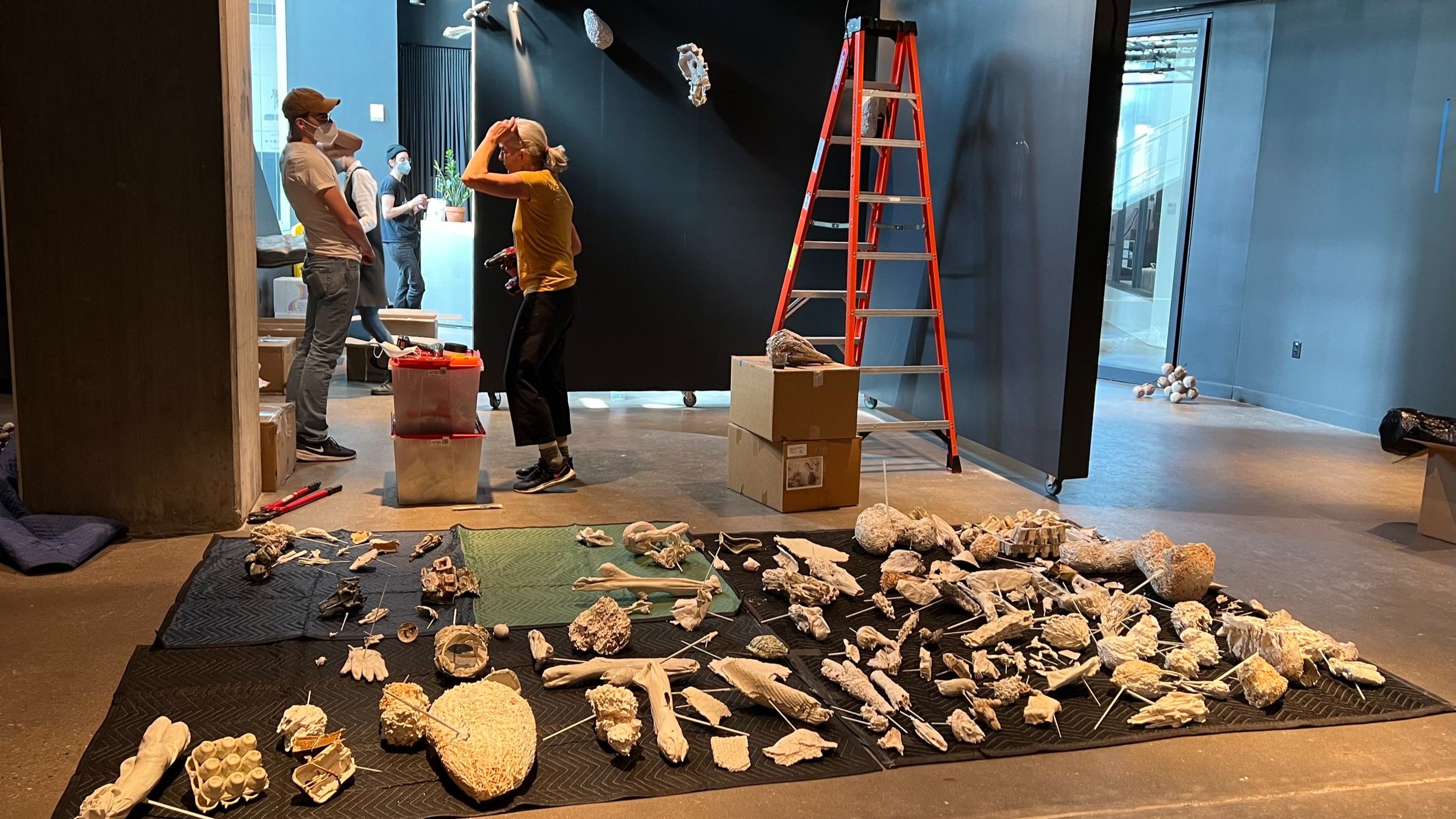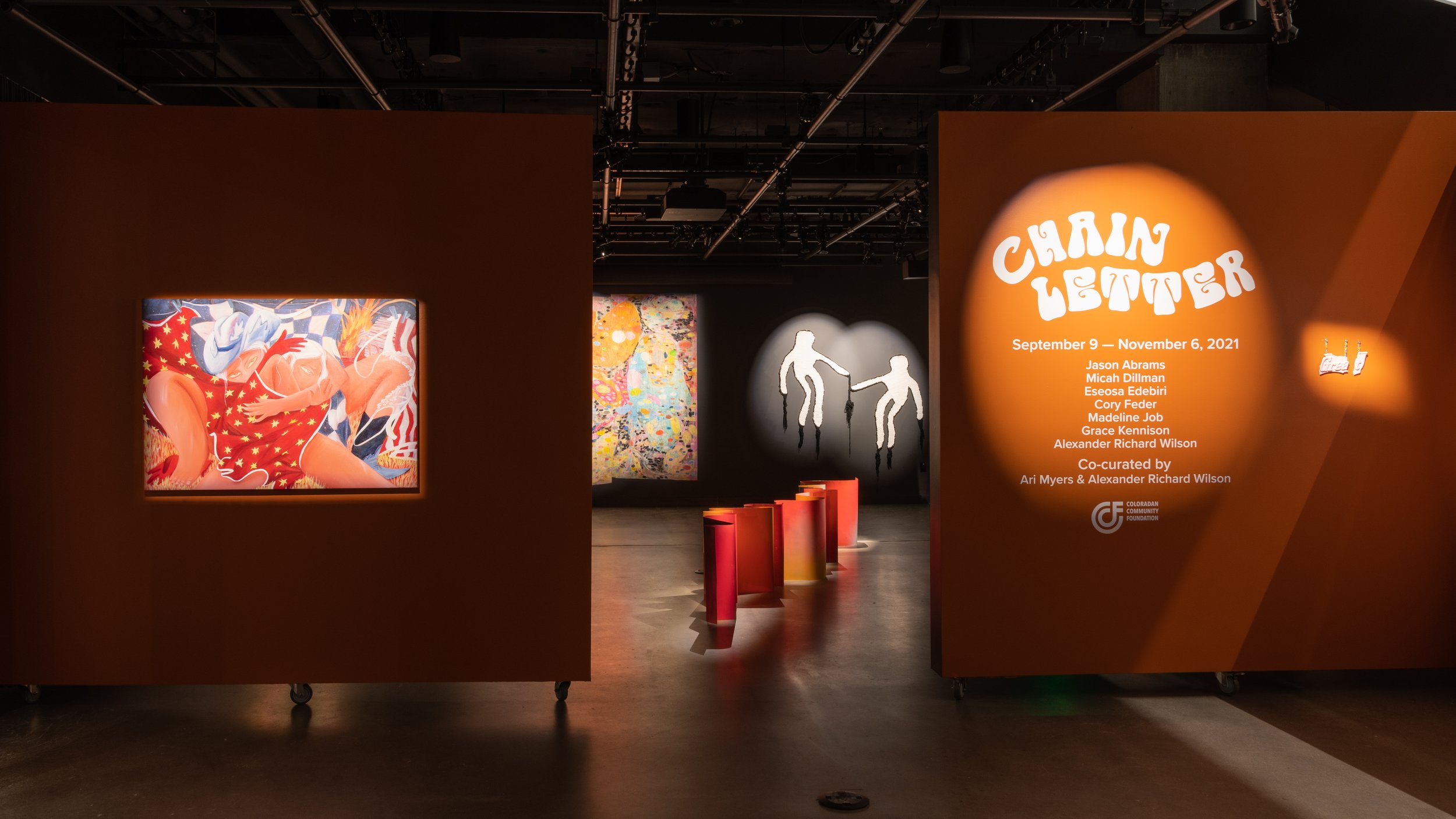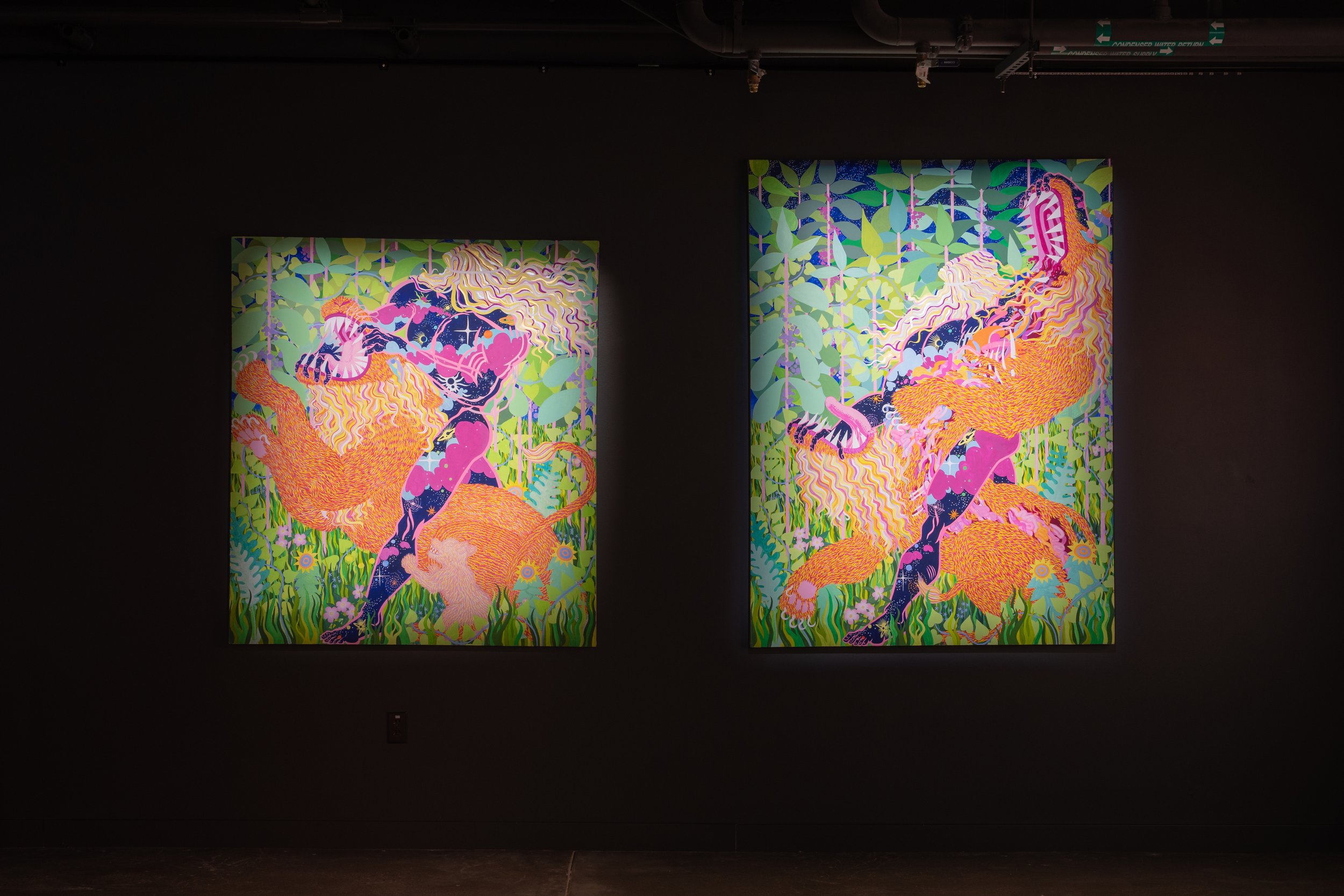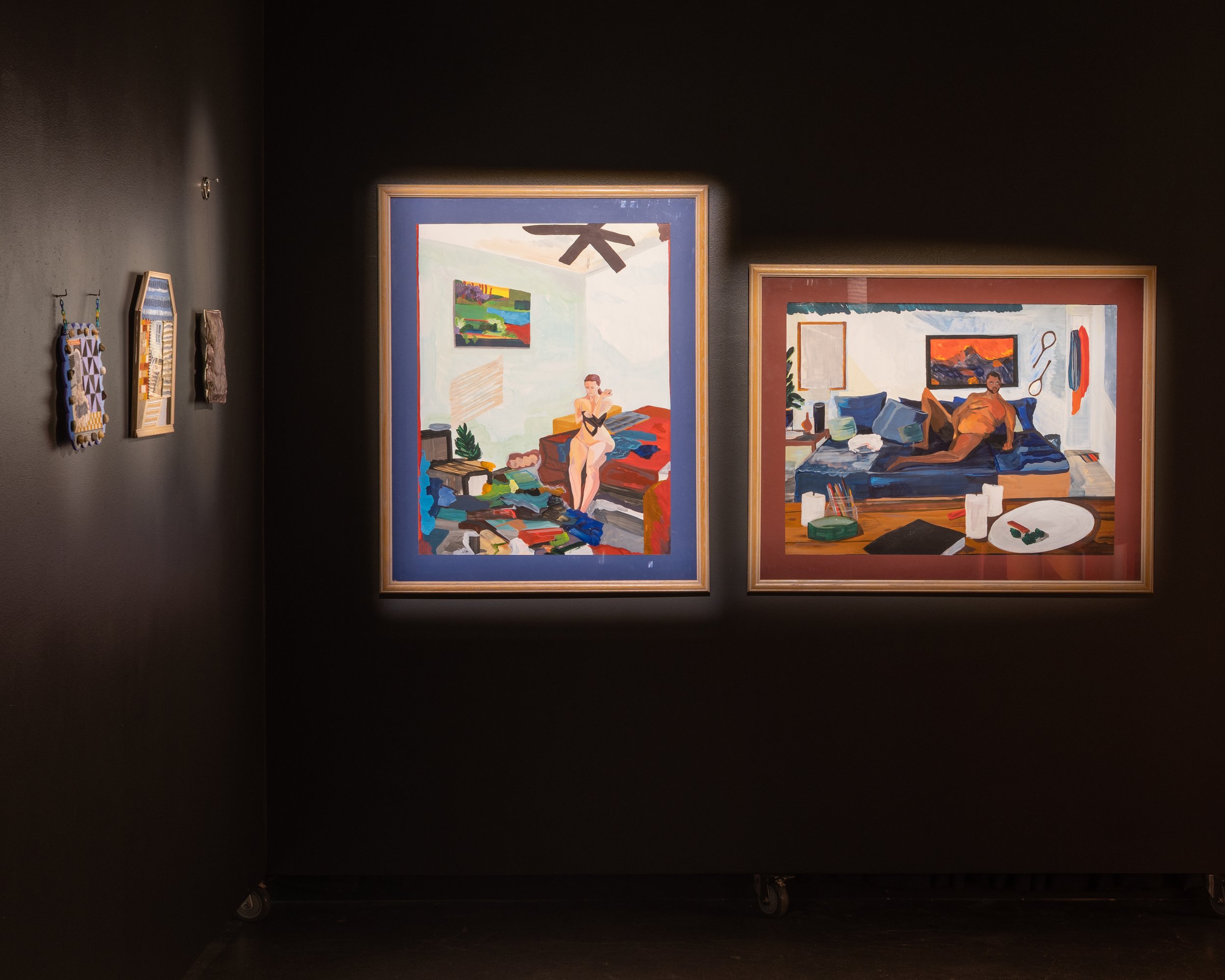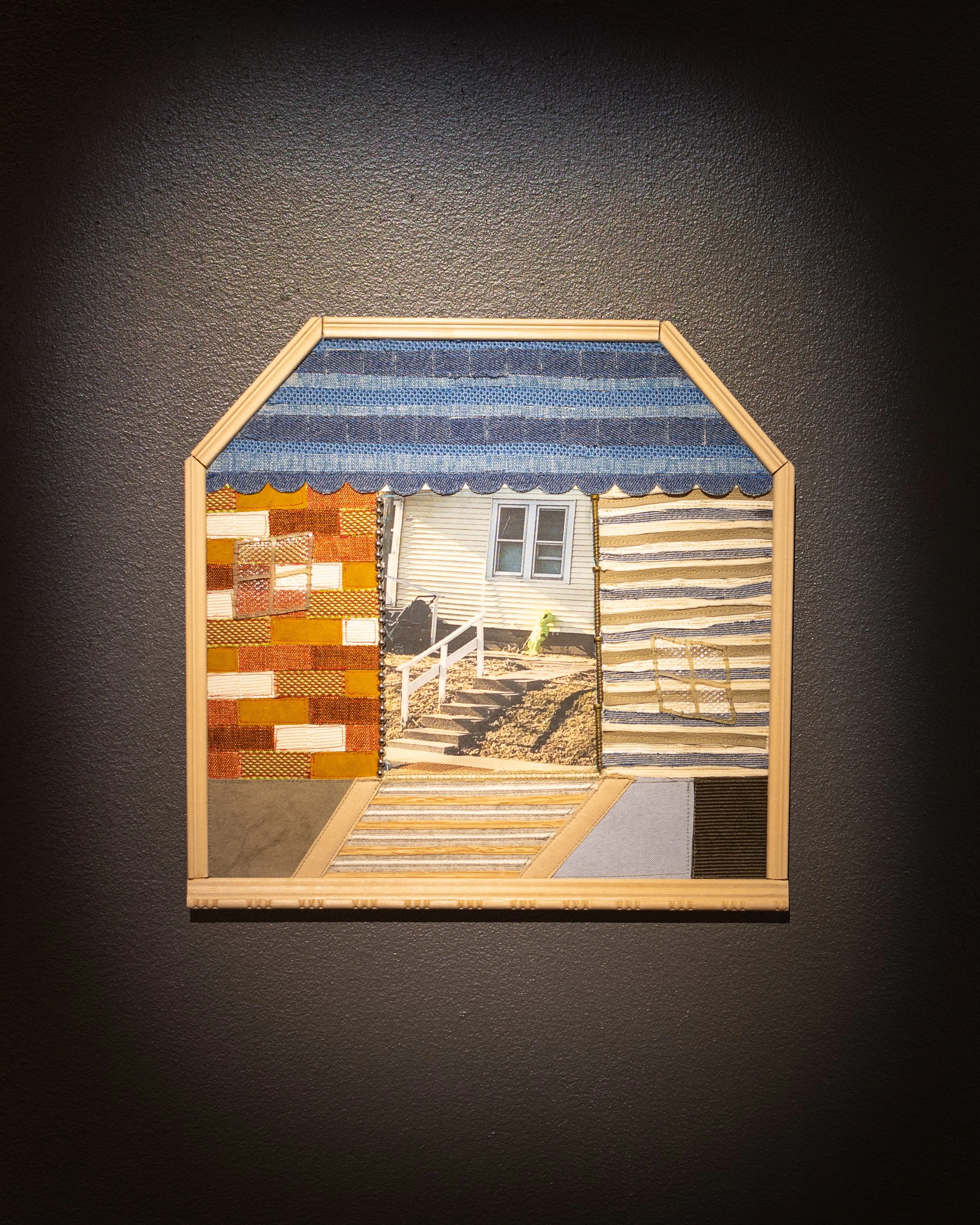
Chain Letter
September 9 — November 6, 2021
Chain Letter is a group exhibition co-curated by artist Alexander Richard Wilson and Arielle Myers. Chain Letter comes as an effort at correlating the depictions and sensations held in form by a collection of artists connected in age, friendship, and an experience of communal loss.
About the Artists + Curators
-

Jason Abrams
(he/him) returned to his hometown of Denver after living and working in Chicago for 9 years. He received his BFA in painting and printmaking from the School of the Art Institute of Chicago (2015). Abrams’ work employs formal elements from comics, cartoons, and children’s book illustrations to reinterpret various narratives including mythology, moments from his own life, and the conventions of figure and landscape painting. These disparate sources meet and merge in his work, creating a combined narrative space wherein uncanniness, reverence, and manic absurdity compete for the viewer's attention. Most recently, Abrams has been engaged in a series of plein-air paintings in collaboration with his father and fellow painter Chuck Abrams, as well as executing a number of direct commissions that have included paintings, large murals, and customized objects.
-

Micah Dillman
(they/them) is a trans nonbinary object maker, performance artist, and fabricator currently living and working in Chicago, IL. Micah was raised in a small town in Iowa and often draws influence from home decor, construction materials, and found absurd miniatures. Their work focuses primarily on the transition from childhood to queer adulthood and reimagining past experiences in a gender affirmative way utilizing woodworking and fiber techniques with constant material exploration. Micah has a BFA from the School of the Art Institute of Chicago and is currently working under several local artists in Chicago.
-

Eseosa Edebiri
(she/her) (b. 1995) is an interdisciplinary artist from The Bay Area, based in Chicago where she received her BFA from The School of the Art Institute. Her work reflects an interest in autonomy and thoughts on intergenerational trauma while having a slight cheeky playfulness to it. She has a very tactile side to her practice exploring touch and accessibility, aiming to create worlds and build settings as well. Giving representation to BIPOC is often present, all too often these stories are told after they've passed. We continue to see instances of police brutality and she aims to touch on these losses without desensitizing us to the trauma of it all, sharing sparks of joy and fleeting happiness that we do experience while we're alive. She has shown work at The New Orleans African American Museum, Prove Gallery, Hyde Park Art Center, Roots & Culture, and more.
-

Cory Feder
(she/her) is a Korean-American illustrator, animator, musician, dancer and sculptor. Born and raised in Denver, Colorado, Cory’s work explores identity through community and - inversely - community through identity.Her work explores human tenderness through nature, folklore, and the divine. Through her re-interpretations of Korean mythology, woven with her own interactions with the natural world, Cory builds a bridge between the past and the present; present and the future.Cory creates a space where time simply flows, rather than be interrupted by human concepts of past, present, and future. Her work leaves viewers feeling both humbled and wholly a part of this universe.
-

Madeline Job
(she/her) was born in Clearwater, Florida and holds a BA in Geography from the University of Florida. She attended Virginia Commonwealth University’s Summer Studio Program in 2017, and is currently pursuing her MFA at the University of Colorado Boulder. Her work has been exhibited across the United States. Influenced by Florida’s tourist culture and recollections of the sea, Job paints her own version of home as a way to fulfill desire for the absent coastline. Exaggerated color and abstracted shapes privilege sensation over representation as she builds a personalized landscape pebble by pebble. Job washes and scrapes each painting in an effort to smooth the surface. The labor in the layering and excavation suggests an intimate struggle to optimize physical reality.
-

Grace Kennison
(she/her) is a painter exploring female-centric visions and stories of violence, resistance, and contemplation of women’s complicated history in the American west. Born in the foothills of Northern Colorado, the bed of the Rocky Mountains near Fort Collins fostered a deep connection to the land and water stretched over the eastern face of the mountain range, which stood defiantly against the heavy urbanization of the Colorado Piedmont and experiences of a burgeoning suburban landscape. Grace’s work supposes land as a natural phenomenon is fundamental to construction of identity, memory, and spirituality as humans. Pulling from a long history of romanticization of western life and land in popular culture and art, her artwork fabulates intersecting narratives and fantasies of white women engaged in embittered relationships with themselves, nature, animal companions, other women, and god. Often reflective of personal views of violence and whiteness in the context of a post-colonial and late-capitalistic western world, the paintings can read as lamentations of failed symbiosis and troubled links to the natural world or the artist’s own identity in honoring and harmonizing with land that feels like home. Today, Grace lives and works on Oĉhéthi Šakówiƞ, Cheyenne, Arapaho, and Núu-agha-tʉvʉ-pʉ (Ute) land in Denver, Colorado.
-

Alexander Richard Wilson
(he/they) is a queer, African American artist working to render the condition of the contemporary american landscape in the midst of the turmoil of climate change. Born (1993) and raised in St. Louis Missouri among five siblings, Alexander was heavily influenced by the St. Louis area’s architectural legacy and the sense of being a part of a whole. Artistically underpinned by a determined architectural sensibility, he seeks to articulate landscape paintings that speak to the American environmental climate as it changes. Upon finishing his BFA at the school of the art institute of Chicago (2017), Alexander worked in the city of Chicago in installations, and the fabrication of sculpture. Upon moving to Lakewood, Colorado in the summer of 2020, with his partner Grace, the conditions present in the mountain west struck a nerve with the artist, and he began generativity painting landscapes that directly represented present extreme weather conditions, and large mountain fires as they burned. His paintings speak to the striking severity of the events unfolding in the mountain west, and a sensibility regarding line and form, formed in the crucible of Chicago’s towering canyons. Alexander has shown these works at Housing, NYC, and Urban Mud Gallery Denver.
-

Arielle (Ari) M. Myers
(she/they) Arielle directed the creative vision of Union Hall, developing all exhibitions, programming, events, and partnerships from 2019 to 2022. She is an advocate and supporter of emerging artists, and brought that passion to Union Hall. Arielle earned her MA in Art History from CU Boulder, and has previously held positions at NINE dot ARTS, the Boulder Museum of Contemporary Art, CU Boulder, and Paul Kasmin Gallery. Ari now owns, operates, and curates her gallery, The Valley, in Toas New Mexico full-time.
